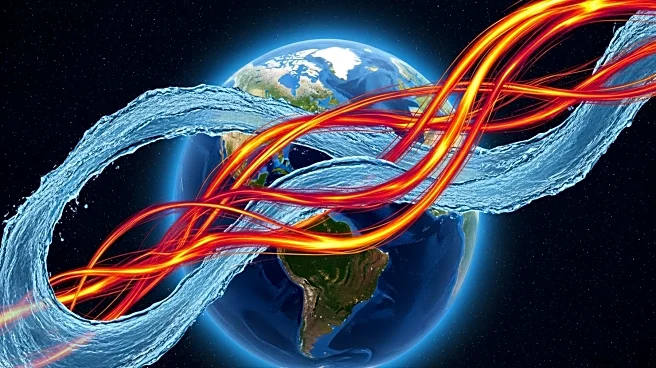What's Happening?
Atmospheric rivers (ARs) have been identified as significant contributors to global freshwater and heat transport, according to recent research. These narrow corridors of concentrated moisture in the atmosphere
are responsible for transporting large volumes of water vapor across continents, often resulting in heavy precipitation when they make landfall. The study highlights the role of ARs in the global water cycle, particularly in regions like the West Coast of North America, Western Europe, and Eastern China. ARs are projected to increase in frequency and intensity due to climate change, potentially leading to more extreme weather events. The research also explores the potential of ARs as future freshwater reserves, although technological and geopolitical challenges remain in harnessing this resource.
Why It's Important?
The findings underscore the critical role of ARs in shaping regional and global climate patterns. As climate change progresses, the increased frequency and intensity of ARs could exacerbate flooding and other hydrometeorological extremes, posing significant challenges for water resource management and disaster preparedness. Regions such as the Sacramento River basin in the U.S. are particularly vulnerable to these changes, which could lead to more severe flood events and impact water supply systems. Understanding AR dynamics is crucial for developing strategies to mitigate their impacts and harness their potential as freshwater sources, which could be vital for addressing future water scarcity issues.
What's Next?
Future research is expected to focus on improving the predictability of ARs and their impacts on regional climates. This includes developing better models to forecast AR pathways and intensities, which could enhance early warning systems for extreme weather events. Additionally, there is a need for international collaboration to address the cross-boundary challenges of utilizing ARs as freshwater resources. Policymakers and scientists will likely explore innovative solutions to manage the risks and opportunities presented by ARs in the context of a changing climate.
Beyond the Headlines
The study of ARs also raises important questions about the ethical and legal implications of tapping into these atmospheric phenomena for freshwater. As ARs often cross international boundaries, their utilization could lead to geopolitical tensions over water rights and resource management. Furthermore, the technological feasibility of capturing and storing water from ARs remains uncertain, requiring significant investment in research and development. These factors highlight the complexity of integrating ARs into global water management strategies.











